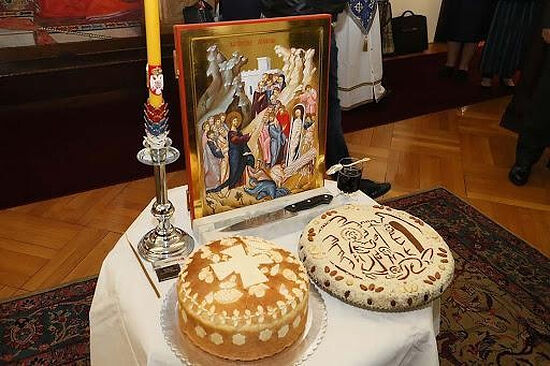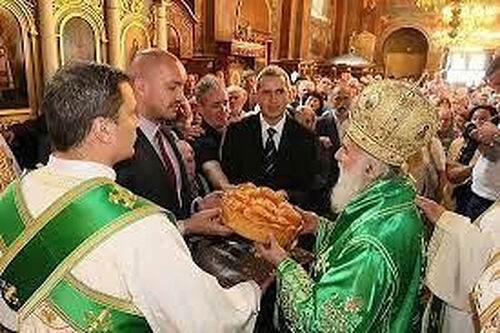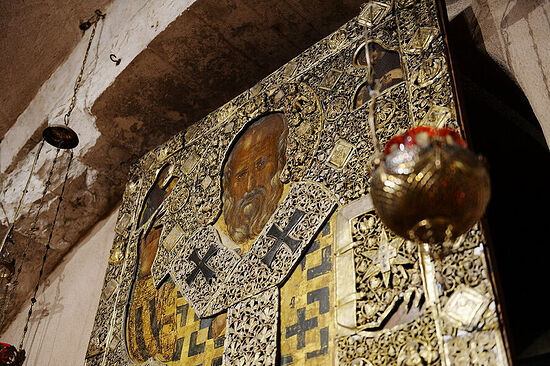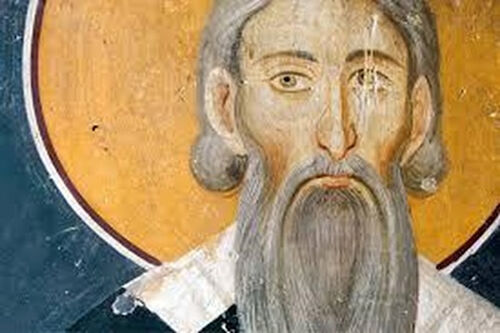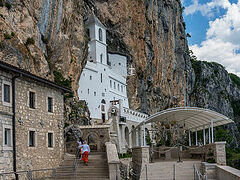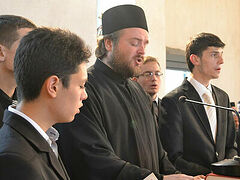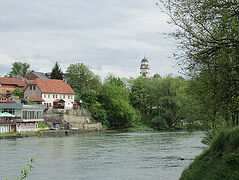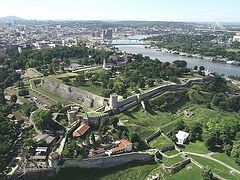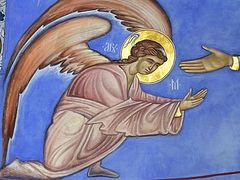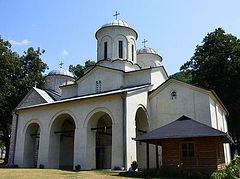A unique phenomenon in world Orthodoxy, Krsna Slava exists only among the Serbs. This centuries-old custom clearly reflects the self-consciousness of the Serbian nation and says much about the peculiarities of the national tradition of the Serbs with its inherent principle of organic dual unity of “faith and blood”, the spiritual and the national. Krsna Slava is the most important family holiday of every Orthodox Serb, honoring the heavenly patron of the whole family through generations. It is celebrated once a year on the feast of the saint to whom Krsna Slava is dedicated.
The festival begins with the blessing of Slava bread (Slavsky kolac), which resembles Russian kulich (Paschal cake) in appearance, but is baked according to a Lenten recipe. This special bread is usually made in the form of a large prosphora with the words, “IS XC” and “NIKA”. On the table next to Slava bread, there is an icon of a patron saint, the Slava candle, incense, red wine and zito—ground wheat with dried fruits. During the ceremony, the priest reads prayers from the Book of Needs and blesses the bread, zito, and the wine, and sings the prescribed troparia, and while singing the hymn, “Rejoice, O Isaiah!”, the host together with the priest turns the Slava bread around in a circle and then breaks it into two with the words: “Christ is in our midst”, “He is and ever shall be.”
After the blessing of Slava bread, which takes place in church before the Liturgy, on the eve of the holiday, or in the house of the host (depending on the clergy’s workload), the festive meal begins. While marking Krsna Slava, the family receives guests throughout the day and shares a meal with their relatives, friends and their children’s godparents. The distinctive feature of this day is that none of the guests is specially invited, because they come a matter of course. All people with whom the family is in contact but who don’t celebrate Krsna Slava on the same day are automatically invited and can come at any time of the day. It often happens that large families celebrate their Krsna Slava for three days. In some Balkan countries where Serbs live (Serbia, Montenegro, Republika Srpska within Bosnia and Herzegovina) every Orthodox Christian is legally entitled to a day off to celebrate his Krsna Slava.
There are several theories explaining the emergence of this interesting custom among the Serbs. The first of them claims that it dates back to pre-Christian era and goes back to the Indo-European tradition (compare with the similar “Lares and Penates” Ancient Roman holiday). During the evangelization of the South Slavic peoples, which began from the sixth to the eighth centuries, some folk festivals were transformed in a Christian spirit with a missionary goal so that people could learn and embrace the Christian faith more easily. Of course, not all ancient customs were adopted. In preserving certain folk traditions, the wheat was separated from the chaff, in accordance to the well-known saying of St. Basil the Great from his Exhortation to Youths: “A Christian can draw even from pagan writers what will be useful and pleasing to his Christian life.”
The second theory claims that the Heavenly patron was chosen in memory of the saint in whose honor the first Serb in the family was baptized, and so Krsna Slava was passed down from generation to generation through the male line. Thus, when a young lady got married, she could celebrate both her Krsna Slava and that of her husband, and her children would observe their father’s Slava.
One of the reasons for choosing one’s Krsna Slava is associated with the feast of the saint in whose honor the first church in the village where this or that family lived was dedicated. Indirectly, this also contributed to the appearance of Prislava (also Pereslava, Prisluzbica), which is celebrated along with the main Slava. The reasons for the Prislava vary. When a family or a young man moves to another village or city, then, wishing to preserve the memory of his birthplace, he chooses a Prislava in honor of his village’s patron saint. Sometimes it happened that during wars or Ottoman invasions, a whole family might disappear; and in order to preserve its memory, their neighbors continued to celebrate the Krsna Slava of this family that suffered death at the hands of invaders. Starting from the early Middle Ages and up to the late nineteenth century, even Catholic Serbs (some regions of Central Dalmatia and Slavonia) observed Krsna Slava. This custom reminded them of their Serbian roots. Once Krsna Slava was also widespread in what is now North Macedonia—cases of the celebration of Krsna Slava are found there even today. It should be remembered that the Archdiocese of Ohrid is of great importance for the history of the Serbian Orthodox Church, and in the twentieth century it was ruled by an outstanding Serbian saint of modern times, Bishop Nikolaj (Velimirovic).
Many examples from real life have been preserved when, as a token of gratitude to God for the salvation and prolongation of one’s life, people began to celebrate the feast of the saint to whom they had prayed for deliverance from death or whose memory fell on the day of their salvation in a variety of circumstances (a battle, an accident, a situation endangering their lives). It is said that Krsna Slava in honor of St. Nicholas the Wonderworker is very common among the Serbs. There is even the following expression: “On St. Nicholas, day half of the Serbs celebrate this Slava, and the other half go to visit them.”
History knows an interesting example of the Montenegrin Vasojevići line, which celebrated the Krsna Slava of a Russian saint—the Right-Believing Prince Alexander Nevsky. Legend has it that people from this family line prayed to St. Alexander Nevsky for help in their fight against Turks, and having received it, began to celebrate the feast of this holy Russian warrior as their Krsna Slava in gratitude.
The memory of significant help from Russian saints is carefully preserved among the Serbian people, and it has recently been possible to come across the custom of celebrating a Krsna Slava in honor of Sts. Seraphim of Sarov, Sergius of Radonezh and Matrona of Moscow. There are churches where the feast of the holy Royal Martyrs is celebrated as their Slava.
More recently, a parishioner of the monastery of Miholjska Prevlaka (once an ancient lavra) near the town of Tivat in Montenegro said that her Prislava was the feast of St. Seraphim of Sarov, who on January 15 (the day of his repose) saved her from imminent death in a car accident after she had prayed to him fervently.
Turning to history, we recall events of the First World War. The Serbs were the victors, but it literally sapped the country’s vitality, because almost two-thirds of the male population died during it. At a particularly decisive and difficult moment for the Serbian army, when it was forced to retreat to the Greek island of Corfu with huge losses, the allies did not provide it with any assistance and remained indifferent to the heroic Serbian soldiers’ suffering. Then the Russian Emperor St. Nicholas II intervened and forced the allies to send ships to save the Serbs and return them to their homeland. During their stay in Corfu, many Serbs chose the feast of St. Spyridon of Tremithus as their cherished Slava in gratitude for their salvation from certain death.
On the feast of the great miracle-worker St. Basil of Ostrog (May 12 according to the new calendar), Serbs celebrate their Krsna Slava in very many cities and villages. In the city of Niksic, where the saint’s incorrupt relics rest, a cross procession of over 40,000 people, which is approximately two-thirds of the city’s population, is held annually.
Krsna Slava is one of the most important Serbian holidays, which is also celebrated by State institutions from the educational to health care. For example, the official holiday of all students, as of all Serbs regardless of their places of residence, is the feast of St. Sava, the enlightener and first Archbishop of Serbia, the founder of the independent Serbian Church (1219). The Russian Church commemorates St. Sava on January 25, and the Serbian Church on January 27, according to the new calendar. The destiny of the Serbian nation, its mentality, spiritual and cultural development, along with the formation of its statehood are inseparably linked to the personality of St. Sava. St. Sava was the royal son of a ruler in medieval Serbia, Stefan Nemanja. The Nemanjic Dynasty celebrated Krsna Slava in honor of the holy Protomartyr Archdeacon Stephen.
The capital of Serbia, Belgrade, celebrates Krsna Slava in honor of the Ascension of the Lord (Serb. Spasovdan). This is a national holiday, and the army and the entire Serbian society participate in the celebration. Republika Srpska in Bosnia and Herzegovina marks its Krsna Slava in honor of the holy Archdeacon Stephen (January 9, new calendar). On this day a solemn military parade takes place, and many cultural events are held. The Patriarch of Serbia also comes to honor this day and share the festive occasion with his flock and the government of Republika Srpska. “For us Serbs, Krsna Slava means both the birthday and the name day—but in the spiritual, not physical sense,” His Holiness Patriarch Pavle of Serbia said.
We stated above that only the Serbs celebrate Krsna Slava. It is thanks to the tradition of celebrating Krsna Slava that the Serbs managed to remain faithful to Orthodoxy and the historical memory of their heroic ancestors even in the Communist times of the second half of the twentieth century, despite the persecution of the Church and the clergy (especially in Montenegro) and the suppression of national customs and traditions. When people had no opportunity to openly confess their faith and go to church, there were those who continued to commemorate the Heavenly patron of their family. History knows other examples when there were various restrictions and even bans on the celebration of Krsna Slava. It was in the times when part of the Serbian nation was under Austrian or Venetian rule. Such bans were imposed under the pretext that festivities were excessive, but in reality, it was motivated by desire to impose the Unia and subject the Slavic populations of these regions to the Vatican’s influence.
Under the godless Tito regime in Yugoslavia (1945–1987) militant atheism was introduced at the State level through the education system and the Communist Party ideology. This was manifested, for example, in the fact that employees in the public service had no right to leave work on the day of their Slava. At the same time, the country’s Communist authorities did their best to suppress the centuries-old tradition of celebrating Krsna Slava by introducing holidays of the so-called “socialist glory”, not least in Vojvodina, where Krsna Slava was ever less celebrated in honor of the patronal feasts of rural churches. The Church nature of Krsna Slava was replaced by an alien meaning: as new reasons for celebration dates were introduced, dedicated to the events of recent history—for example, the day of the liberation of a city or town from Nazi occupation. This was despite the fact that during the Second World War, most of Orthodox Serbs (including the real Serbian elite) were physically exterminated not even by the German or Italian occupiers, but by the Tito Communists themselves and the Ustashe whom they covered up.
Krsna Slava is an ancient Serbian custom, thanks to which for many centuries the spiritual memory of the Serbian people has been preserved and their national self-consciousness strengthened. This allowed the Serbs to remain faithful to Orthodoxy and preserve their national identity during the times of the Turkish or Austrian occupations, as well as during the hardest period of the Communist yoke. Interestingly, this special Serbian tradition has become noticeable outside the Serbian world—the tradition of celebrating Krsna Slava was included in the UNESCO World Heritage in the sphere of education, science and culture as a Serbian intangible cultural heritage.
Today the vast majority of Serbian people celebrate Krsna Slava, and despite the colossal pressure from the West, are steadily returning to their faith of St. Sava, to their national roots and Orthodox history.

